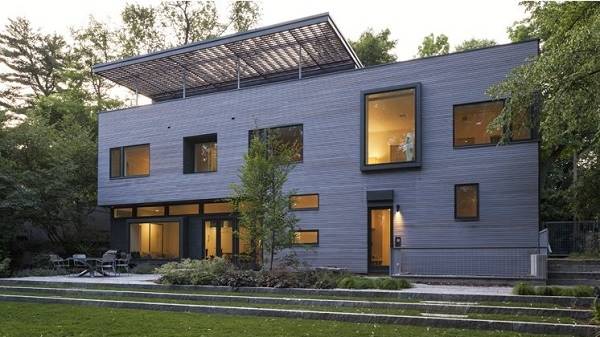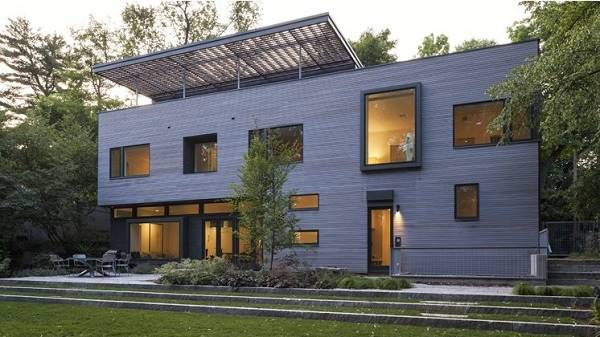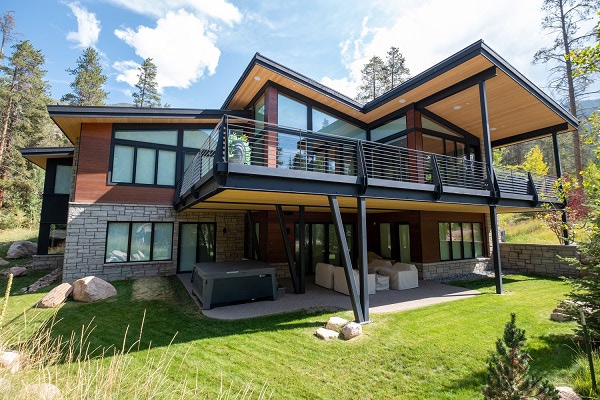
15 Problems With Wood Siding and How to Avoid Them
Written by Liza Sivek onWell-built homes deserve timeless curb appeal that matches the homeowner’s expectations and the expertise of the architect and builder. Wood siding is a preferred choice for the natural beauty and distinct aesthetic. But are concerns about traditional wood siding durability making you afraid to use it in your project? This guide explores 15 common issues with wood siding and offers solutions that help you keep the beauty of real wood with minimal maintenance.

Ipe wood rainscreen siding on exterior, soffits, and surrounding the entryway
Download the Ultimate Guide to Wood Rainscreen Siding here to learn more about choosing the best performing wood and installation for your exterior design:
Beyond the Misconceptions: High-Performance Wood Solutions
The internet might be full of articles describing the high-maintenance nature of wood siding. Not all wood siding is created equal. Certain species offer superior performance and aesthetics and knowing the difference is key to satisfaction with your siding choice.
You can achieve a luxurious, low-maintenance exterior design that will stay attractive and perform better and more reliably for decades. Knowing the right types of wood siding - and installation methods - to get the most out of exterior design will let you make an educated and confident choice.
 Hardwood siding with vertical rainscreen installation
Hardwood siding with vertical rainscreen installation
Wood That Weathers with Grace and Strength
One often repeated concern with traditional wood siding is its susceptibility to warping and cupping from moisture. This can be avoided with proper acclimation and pre-installation UV protectant.
Weathering wood can weaken some species, such as Cedar, lose durability as they weather and age from UV exposure, rain, and storms. This is not the case with hardwood. These exceptional woods retain their structural integrity even when they naturally age and develop a beautiful silver-grey patina.
 Cumaru hardwood siding after 12 years of weather exposure
Cumaru hardwood siding after 12 years of weather exposure
RELATED: Download the Guide to How Exterior Woods Weather to learn more
Problems Solved: Designing with Confidence
 New Cumaru rainscreen vertical siding installation with wrapped corners
New Cumaru rainscreen vertical siding installation with wrapped corners
“Wood siding requires frequent repainting or re-staining which is expensive and time consuming.”
Not necessarily. Hardwoods already have beautiful natural color ranges and a simple oil-based UV protectant applied periodically maintains their luster. (We have had the best results using Penofin Hardwood Penetrating Rosewood Oil UV Protectant that protects and enhances the beautiful color and grain of your wood siding.)
And - you can choose to stop using the oil sealant at any time if you decide you want your siding to weather. Weathered hardwoods exhibit a beautiful silvery-gray patina and still maintain high resistance to moisture, insects, and checking.
Ready for more? The Ultimate Guide to Rainscreen Siding has lots of information, options and details to help you create your exterior home siding vision:
Price vs. Value: What’s The Return on Your Investment?
A life cycle cost analysis of the siding species can reveal the high or low return on investment. Low-maintenance, durable siding material that lasts more years is the key to a better return on investment.
Hardwoods are shown to deliver the highest ROI (return on investment) of these wood siding options. Not only do they have a high natural bending strength, durability and resiliency than lower density species they stay attractive much longer.
 Wood siding adds natural warmth and beauty to a stone facade that no other siding material can truly replicate
Wood siding adds natural warmth and beauty to a stone facade that no other siding material can truly replicate
Sustainability Is Possible In Wood Siding
“Wood siding isn’t environmentally friendly.”
-1.jpg?width=600&height=300&name=Sustainable%20harvesting%20practices%20(600x300)-1.jpg) Sustainable, environmentally- and community-friendly, harvesting practices in Guatemala forest are certified by FSC and the Rainforest Alliance
Sustainable, environmentally- and community-friendly, harvesting practices in Guatemala forest are certified by FSC and the Rainforest Alliance
Responsibly managed forests are the key to providing sustainably harvested wood siding. In today’s construction landscape, homeowners, designers and builders all prioritize sustainable building practices. Wood siding solutions that boast certifications for responsible forestry practices are high on the project criteria list.
Mataverde hardwoods and ThermaWood Hem-Fir are sourced from sustainably managed forests, ensuring minimal environmental impact. Additionally, these wood products offer a long lifespan, reducing waste compared to short-lived siding materials. And they are all safely recyclable when it’s time to replace and dispose of them.
Check out our Environment page to see our commitment to sustainable and responsible harvesting and the certifications we hold and follow.
Species Spotlight: Knowing The Differences
When discussing wood siding material, there are two main categories: Softwood and Hardwood. Before deciding on siding, it’s important to know the difference.
Softwood siding species have naturally low fiber density and are more porous. Popular quality softwood wood siding options include Western Red Cedar and Redwood. Here are the pros and cons of softwood siding:
 Softwood siding will show damage from UV and weather exposure sooner than hardwoods and require more maintenance, protection, and repairs over its lifetime use. Softwood siding damage includes splintering and checking, as seen above.
Softwood siding will show damage from UV and weather exposure sooner than hardwoods and require more maintenance, protection, and repairs over its lifetime use. Softwood siding damage includes splintering and checking, as seen above.
Softwood Siding
Pros
- Paintable or stainable
- Moderate insect resistance depending on the wood species.
- If you desire a rustic look, softwood sidings are available in knotty grades at a lower cost.
Cons
- Requires frequent refinishing
- Low resistance to moisture damage
- If you prefer a smooth, modern looking exterior, softwoods tendency to show dents and wear may not be right for you.
- Clear vertical grain Western Red Cedar is hard to find
- Low resistance to gouging and damage from flying storm debris or rubbing tree limbs, creating higher frequency of repairs.
- Lower bending strength and durability can lead to breakage and repair
- Softwood siding requires extra maintenance to prevent rotting, checking, splitting, cracking or breakage
 Wood rainscreen siding lends itself to all styles of exterior, like this vertical Garapa rainscreen on a traditional home
Wood rainscreen siding lends itself to all styles of exterior, like this vertical Garapa rainscreen on a traditional home
Hardwood Siding
Hardwood is the opposite, hence the name, with naturally high fiber density and low porosity. Frequently specified siding options include the Ipe, Jatoba, Machiche, Cumaru, and Garapa wood species. These wood types have a higher resiliency against common everyday threats to your exterior and stay durable and attractive longer.
Pros
- Naturally very high resistance to moisture, rot, and decay
- Very high resistance to insect damage
- High resistance to checking, splitting and cracking - even if weathered
- Excellent scratching and wear resistance
- Low repair and maintenance needs
- High resistance to damage from flying storm debris and rubbing tree limbs.
- Popular color ranges in each species, including golden blondes, red-browns, medium browns, and dark browns
Cons
- Not paintable
- Stainable, but requires special hardwood penetrating oil based stains

Ipe hardwood rainscreen, stained before installation with Seal-Once gray tint for an instantly weathered looked
Thermally Modified Wood:
An excellent third option is thermally modified Hemlock wood. Thermally modified hemlock is a softwood that has been through a process with heat and steam in a pressure kiln to remove the sugars from the wood which makes it harder and more resilient.
 Mataverde ThermaWood Hem-Fir siding with a clear finish
Mataverde ThermaWood Hem-Fir siding with a clear finish
Pros
- Thermal modification gives the hemlock comparable characteristics to hardwood
- High insect resistance
- Highly stable - minimal expansion and contraction
- High rot and decay resistance
- Paintable and stainable
- Can be left natural with a clear UV protectant
- Can be weathered to gray naturally
- Has a very similar look to Western Red Cedar at a much lower price point

Cons
- Thermally modified wood is less durable than some hardwoods, (but significantly higher than unmodified hemlock or other softwoods)
- Thermally modified hemlock may need an occasional re-staining or repainting as needed.
%20ThermaWood%20FR%20Hem-Fir%20Siding%20Project%202024/ThermaWood%20FR%20Hem-Fir%20Siding%20side%20entryway%20view%20The%20Ridge%20House%20project%20CA.jpg?width=973&height=649&name=ThermaWood%20FR%20Hem-Fir%20Siding%20side%20entryway%20view%20The%20Ridge%20House%20project%20CA.jpg) ThermaWood thermally modified wood siding with a stained finish
ThermaWood thermally modified wood siding with a stained finish
Beyond Siding Boards: Installation Makes a Difference

Incorrect installation that does not allow water and moisture to escape can create the potential for mold and rot to develop behind your siding
The installation method you choose for your exterior siding plays a significant role the performance, maintenance needs, and longevity. The two most common options are closed joint rainscreen installation and open joint rainscreen installation.
Tongue and groove siding is often installed over wood furring strips in a grid behind the siding. Moisture and humid air can escape up, evaporating out the top of the siding wall, or run out the bottom.
An open joint rain screen allows water and air to move through the siding, with planned gaps between the siding boards that allow water to run out or evaporate throughout the siding wall.
Mataverde Climate-Shield Wood Rainscreen Wood Siding System gives you an innovative approach to proper ventilation behind the siding, preventing moisture build up – a leading cause of rot and mildew. This rainscreen system also enhances energy efficiency and provides superior protection against the elements.
 An illustration of the Climate-Shield Wood Rainscreen System and how it works
An illustration of the Climate-Shield Wood Rainscreen System and how it works
The Climate-Shield system eliminates the wood furring strips behind the siding and replaces it with aluminum clips and starter rail. These components create the perfect rainscreen gap between the siding boards, allowing water to escape at multiple points, so it won’t be trapped behind the siding.
Now that you can compare the differences, which wood siding will you choose for you project? Have you changed your mind on the best option for your exterior? Let us know what you think, and if you have questions or need more information, please contact us. We’re ready to help.

Related Posts



